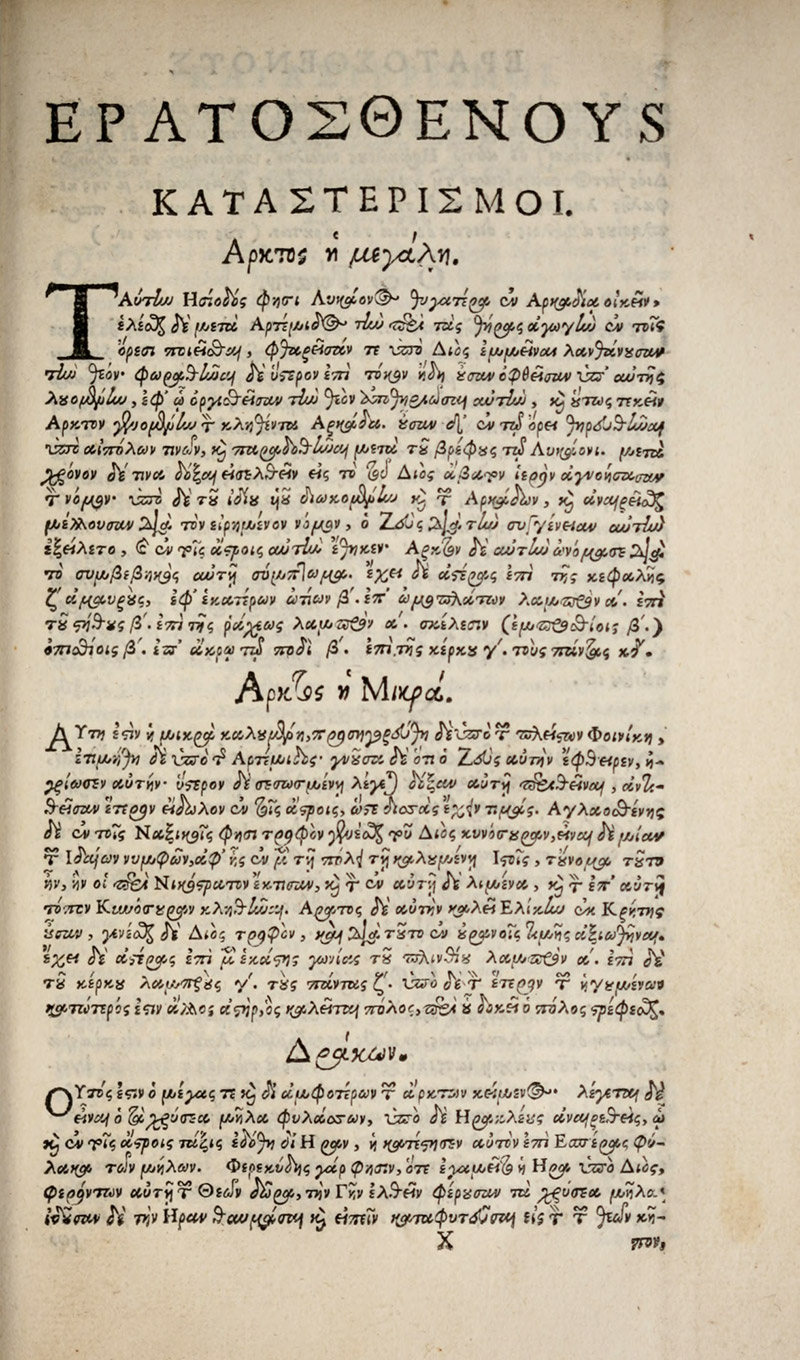Star Mythology: Eratosthenes’ Catasterismi

- Eratosthenes, Catasterismi: the myths and astrothesia of the Great Bear, the Small Bear, and the Dragon.
- Aratou Soleōs Phainomena kai Diosēmeia. Theōnos scholia. Eratosthenous katasterismoi. Metron tēs gēs Peripherias. Tou kyvou diplasiasmos. Koskinon. Tou Neilou pēgai. Tou kanonos tomē Dionysiou hymnoi. Accesserunt annotationes in Eratosthenem et hymnos Dionysii. Ed. John Fell.
- Oxford: The Sheldonian Theater, 1672.
Aratus tells very few myths about the origin of constellations. Aside from the long myth concerning Virgo, identified with the goddess of Justice who, disgusted with the behavior of the humans of the Bronze Race, flew up in the sky and became a constellation (Phaen. 96-136), Aratus briefly hints at the mythical stories behind the Bears (Phaen. 30-35), the Horse (Phaen. 216-223), and Orion (Phaen. 637-646). The addition of mythological narratives to explain the origin of constellations is due to Eratosthenes, a polymath, a scientist and a scholar who was also the director of the Alexandrian Library in ca. 240-201 BCE. Among his many works are the so-called Catasterismi (lit. “Placings among stars”), in which he narrated the myths behind all the constellations described by Aratus. The work is not preserved in its original form, but we have two versions, an epitome preserved in several medieval manuscripts and the so-called Fragmenta Vaticana, as their main source is a Vatican manuscript (Vat. gr. 1087, dating to 14th century CE).
The Catasterismi collect 44 entries, including all the constellations (1-42), the planets (43), and the Milky Way (44). In each entry, Eratosthenes tells the mythical story behind each celestial body; for the constellations in particular, he also gives a list of stars that form a given constellation (the so-called astrothesia) for a total of 736 stars.
We see here the first page of the Catasterismi in a 1672 edition with the myths concerning the Great Bear, the Small Bear, and the Dragon. The narrative for each constellation is followed by the list of stars that belong to it. For each star a brief description is given of where the star is located, either on different body parts in the case of animals or human figures, or at some location within the object that lends its name to the constellation. Unfortunately, just like with Aratus, no coordinates are provided in these descriptions, so it is very difficult to reconstruct the constellations as envisaged by Eratosthenes.
The editor of this edition was John Fell (1625-1686), Bishop of Oxford, scholar, and administrator, who established a press in the Sheldonian Theatre, which had just been opened in 1669. Apart from his role as editor of Latin and Greek texts, Fell closely supervised the printing of more than 150 titles, even importing punches and matrices from Holland in order to cast Roman, Greek, and italic type. Some of these punches were cut by prominent type-designers such as Robert Granjon and Christoffel van Dijck. The so-called “Fell types” were used in Oxford into the eighteenth century.
Eratosthenes did not invent these myths, he merely connected stories which had been known by the Greeks for many centuries to constellations. His innovation was indeed the “catasterism”, that is, the identification of a specific constellation with individual heroes, heroines or mythical animals who, according to the catasterism, had been elevated to the sky by the gods (before Eratosthenes, only Orion and the group of the “Andromeda myth”, namely Perseus, Andromeda, Cepheus, and Cassiopeia, were identified with mythical characters).